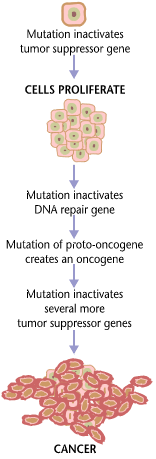Everyday Carcinogens - Asbestos
Cancer is definitely one of the top leading causes of death in the world. A study from cancer.org says:
In 2018, there will be an estimated 1,735,350 new cancer cases diagnosed and 609,640 cancer deaths in the United States.
If those numbers don't scare you then I don't know what will. This kind of begs the question "why are so many people victims of cancer?"
Is it just nature's way of punishing the human race or is there more to it than meets the eye? Could it be something we are doing wrong (intentionally or unintentionally) on our part? If it is part of our own doing, how can we reduce our risk of exposure to cancer?
Cancer is now a malignant problem in our health sector and like all problems, you must first understand the cause in order to solve it.
If you are unable to understand the cause of a problem, it is impossible to solve it. – Naoto Kan.
What causes cancer?
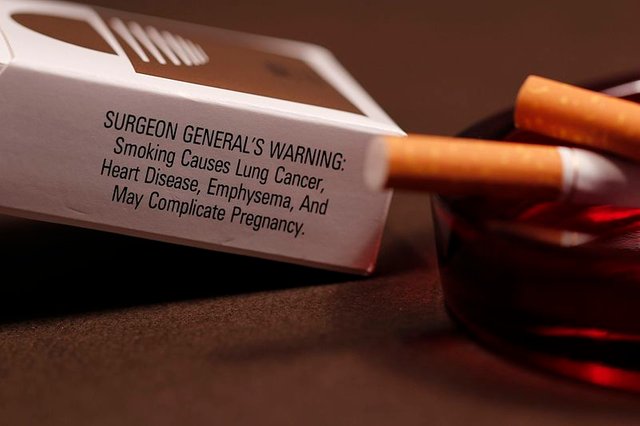 source: Wikicommons license: CC BY-SA 3.0
source: Wikicommons license: CC BY-SA 3.0
Cancer is not caused by just one exposure or occurrence but by a combination of things and occurrence that leads to changes in genetic makeup which results in the multiplication and proliferation of cells uncontrollably which eventually develops into a tumor. Cancer develops as a function of age, environment, diet, and genetic makeup.
A cancerous growth could be hereditary or sporadic (non-hereditary). Hereditary cancer are caused by inherited genetic defects and are less common compared to sporadic cancer.
Vast majority of cancerous growth are caused by a number of factors which are: virus, radiation, smoking, carcinogens, hormones and chronic inflammation of organs. All of which are mostly environmentally-induced. Of all these; carcinogens are the leading causes of most cancer.
What are carcinogens?
Carcinogens are basically any substance - physical, chemical, biological or radioactive that can potentially cause cancer. There are a lot of substances that can cause cancer ranging from solid (example: Asbestos) to gas (smoke exhaust) medium.
According to the International Agency of Research on Cancer (IARC), the United States Environmental Protection Agency (EPA), and the United States National Toxicology Program’s Report on Carcinogens (RoC), there are more than 100 known human carcinogens. To mention a few examples are: *lead, benzene, Arsenic, leather dust.
Carcinogenesis
This is simply the transformation of normal cells to cancer cells. It is also known as "Oncogenesis". Cancer initiates from a single cell which then start developing by multiplying creating identical defected and mutated cells. Cell division is a physiological process that cells exploit to multiply and it occurs in almost all tissues. Normally, there is an equilibrium (balance) between cell proliferation by dividing and cell death by apoptosis and this balance is constantly maintained by the DNA for the efficient running of the tissues and organs which are made of group of cells. What carcinogen does when in substantial amount is that it causes mutations in DNA and epimutations that interferes with mechanism involved in keeping a balance between cell proliferation and cell death. Thus interference leads to an uncontrolled cell division rate thereby causing cancerous cells to multiply faster than they are killed.
In other words, for a normal cell to transform into a cancer cell, genes that regulates the process of cell division must be altered either by inheritance or Mutation.
Here's a video that shows how cancer cells are formed by cancer research UK
It can take many years for a damaged cell to divide and proliferate to cells large enough to form a tumor where symptoms starts becoming evident.
Asbestos: cancer-causing agent
Asbestos are naturally occurring silicate minerals. Like other silicate minerals, they are found in rocks and soils. They are long, thin and fibrous with color variety (blue, brown, green and white).
People have been mining asbestos for over 4000 years now and it became very popular in the 19th century because of its physical characteristics which makes it a very good material for construction and building. Some of these characteristics include: resistance to fire, heat and electricity, sound absorption, and tensile strength.
All these properties makes it very versatile mostly in building materials (roofing shingles, ceiling and floor tiles, paper products, and asbestos cement products) and frictional products (automobile clutch, brake, and transmission parts)
 Ceiling boards containing high percentage of asbestos. Credit: moshroom
Ceiling boards containing high percentage of asbestos. Credit: moshroom
Asbestos minerals are divided into two major groups: Serpentine asbestos and amphibole asbestos. Serpentine asbestos has the mineral chrysotile which has long and curly fibres. 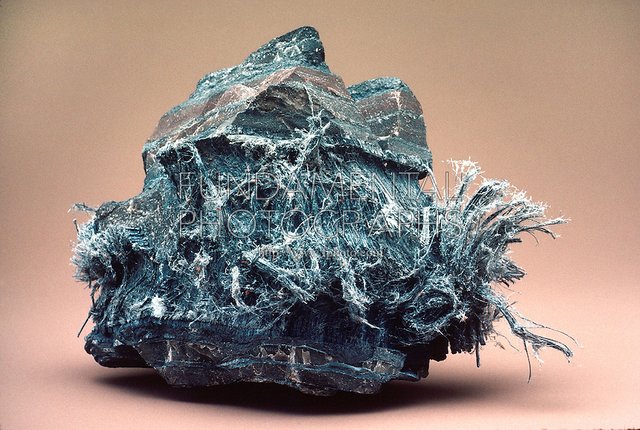 Natural form of chrysotile asbestos mineral stone with curly fibres. Source
Natural form of chrysotile asbestos mineral stone with curly fibres. Source
Chrysotile is most commonly used for industrial and commercial purposes because it is more tensile and can be interwoven. Amphibole asbestos includes the minerals actinolite, tremolite, anthophyllite, crocidolite, and amosite. Amphibole asbestos has straight, needle-like fibers that are more brittle than those of serpentine asbestos
Where can asbestos be found?
- Vinyl floor tiles and the backing on vinyl sheet flooring and adhesives
- siding shingles and Roofing sheets along with Ceiling boards.
- Walls and floors around wood-burning stoves protected with asbestos paper, millboard, or cement sheets
- Hot water and steam pipes covered with an asbestos blanket or tape
- Clutches and brakes of automobiles
- soil and rocks: naturally occurring asbestos
How do they cause cancer?
Asbestos contains fibres that are usually released when when the material is disturbed by abrasion or any other way for that matter. When these fibres are released in the air, some can be inhaled and transport themselves through the nostrils, then the throat and eventually end up in the lungs. They settle there for a very long time (because asbestos are heavy minerals) and if inhaled long enough especially on a regular basis, they cause long term inflammation and scarring of the lung tissue. This type of infection is non-cancerous and its called asbestosis. Asbestosis makes breathing more difficult and is usually accompanied by chest pain and cough.
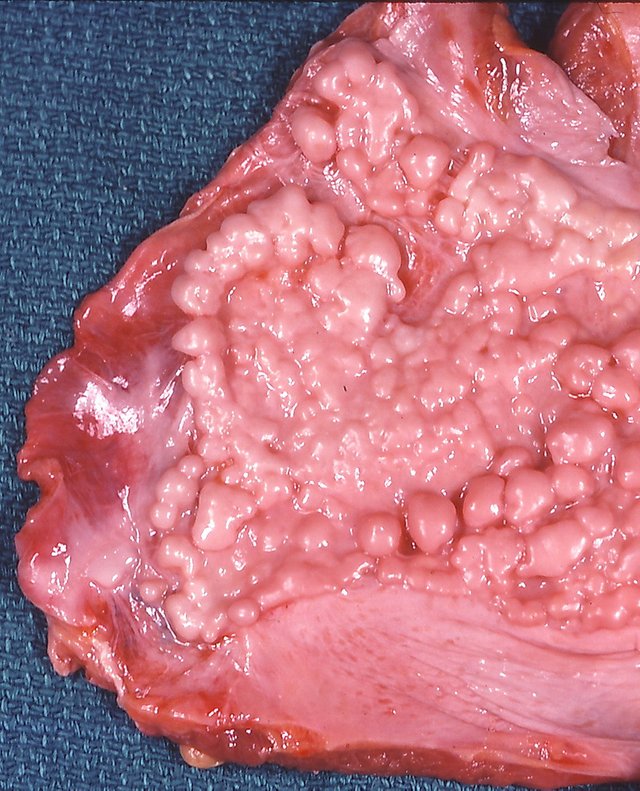 Asbestosis: A firous plague on the diaphragmatic pleura. Source: Flickr
Asbestosis: A firous plague on the diaphragmatic pleura. Source: Flickr
In most cases asbestosis, if not properly monitored can escalate to cause mesothelioma (which is a type of cancer that affects the tissues that covers the organs of the mesothelium) or lung cancer - which is basically the presence of a tumor in the lungs.
Who is at risk of this carcinogen?
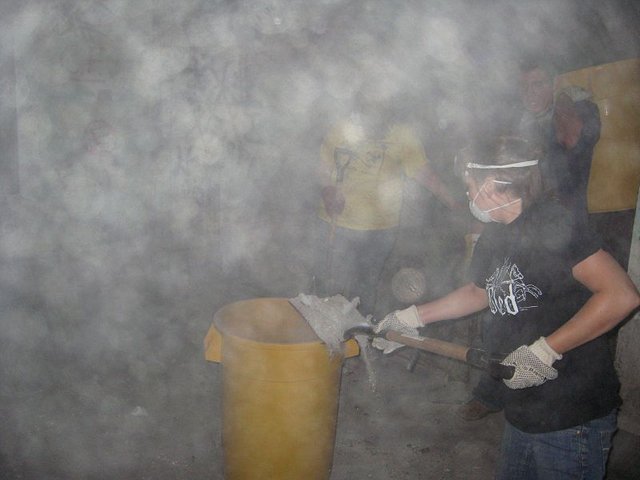 Workers exposed to asbestos. Source: Wikicommons License: CC BY-SA
Workers exposed to asbestos. Source: Wikicommons License: CC BY-SA
Potentially, we can say everybody bears a risk of exposure to a certain degree at some point because asbestos are kind of ubiquitous but the level of asbestos fibres around us are very negligible that they rarely lead to any illness.
I wish I could say the same for the workers that work with companies that produce asbestos related products as they have risk factor involved as they work directly with the material or have substantial environmental contact.
There is a study that proofs that the immediate family members of workers that are heavily exposed to asbestos show a very high risk of developing mesothelioma. The risk is considered as a result of the asbestos fibre remnants in the clothes, shoes and hair of the worker, which he/she brings home. Because of this, there has been federal law regulation practices placed on workplaces to avoid workers from bringing asbestos fibre home. Some of the practices include taking a shower after work and storing your work clothes in a separate place from the cloth you wear home and many other regulations.
How can we prevent/protect ourselves?
- If you encounter any asbestos related material in your school, workplace, house or anywhere it's best not to disturb the material so as not to upset the settled fibres. As they say *let the sleeping
dogsasbestos lie. - And If you must work closely with asbestos related material, always wear a safety nose mask to stop you from inhaling the fibres and read this from the Occupational Safety and Health Administration (OSHA) on how to better protect yourself against asbestos at work.
conclusion
When I first learnt about asbestos as a carcinogen I instantly became very cautious of the way I interacted with my environment - I think I may have overreacted at the time, do you blame me? Asbestos is still widely used in building materials in Nigeria. It is imperative that we understand that though asbestos is still all around us,they are in very small quantities which are harmless to our health. So you need not worry because there's a higher probability of you dying from the stress of worry than cancer caused by asbestos (really? Okay am kidding)
Though we might have a low risk of getting cancer through asbestos, there are still other carcinogens out there we encounter in our everyday lives like exhaust form automobiles especially those from diesel engines. So please ensure to read here for further knowledge on how to protect ourselves from everyday carcinogens.
Thank You for your time and attention. Peace out!
References
- Asbestos exposure and cancer risk
- Carcinogenesis: Mechanisms and Manifestations by David E. Malarkey, Mark Hoenerhoff, Robert R. Maronpot
- National Cancer Institute, 2004 analysis and recommendations Cancer.gov. 2004-09-15. Retrieved 2010-09-22.
- "What is asbestos?" American Cancer Society. Retrieved 12 January 2010.
- Asbestos - History and Uses Wisconsin Department of Natural Resources. 31 August 2007
- A brief history of asbestos, use and associated risk
- How does asbestos cause cancer?
- Wikipedia
